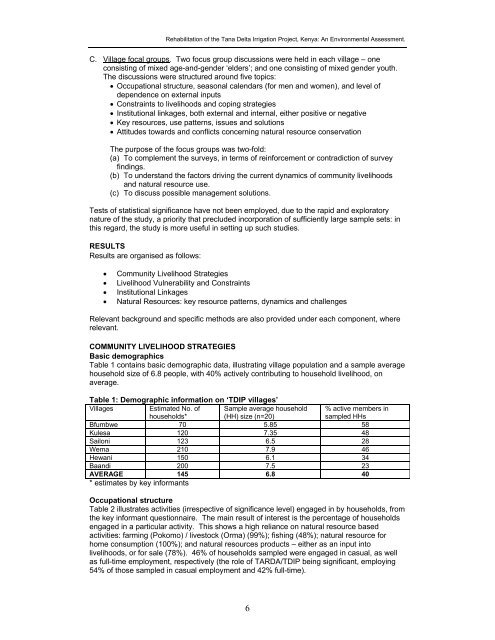Tana Delta Irrigation Project, Kenya: An Environmental Assessment
Tana Delta Irrigation Project, Kenya: An Environmental Assessment
Tana Delta Irrigation Project, Kenya: An Environmental Assessment
You also want an ePaper? Increase the reach of your titles
YUMPU automatically turns print PDFs into web optimized ePapers that Google loves.
Rehabilitation of the <strong>Tana</strong> <strong>Delta</strong> <strong>Irrigation</strong> <strong>Project</strong>, <strong>Kenya</strong>: <strong>An</strong> <strong>Environmental</strong> <strong>Assessment</strong>.<br />
C. Village focal groups. Two focus group discussions were held in each village – one<br />
consisting of mixed age-and-gender ‘elders’; and one consisting of mixed gender youth.<br />
The discussions were structured around five topics:<br />
• Occupational structure, seasonal calendars (for men and women), and level of<br />
dependence on external inputs<br />
• Constraints to livelihoods and coping strategies<br />
• Institutional linkages, both external and internal, either positive or negative<br />
• Key resources, use patterns, issues and solutions<br />
• Attitudes towards and conflicts concerning natural resource conservation<br />
The purpose of the focus groups was two-fold:<br />
(a) To complement the surveys, in terms of reinforcement or contradiction of survey<br />
findings.<br />
(b) To understand the factors driving the current dynamics of community livelihoods<br />
and natural resource use.<br />
(c) To discuss possible management solutions.<br />
Tests of statistical significance have not been employed, due to the rapid and exploratory<br />
nature of the study, a priority that precluded incorporation of sufficiently large sample sets: in<br />
this regard, the study is more useful in setting up such studies.<br />
RESULTS<br />
Results are organised as follows:<br />
• Community Livelihood Strategies<br />
• Livelihood Vulnerability and Constraints<br />
• Institutional Linkages<br />
• Natural Resources: key resource patterns, dynamics and challenges<br />
Relevant background and specific methods are also provided under each component, where<br />
relevant.<br />
COMMUNITY LIVELIHOOD STRATEGIES<br />
Basic demographics<br />
Table 1 contains basic demographic data, illustrating village population and a sample average<br />
household size of 6.8 people, with 40% actively contributing to household livelihood, on<br />
average.<br />
Table 1: Demographic information on ‘TDIP villages’<br />
Villages<br />
Estimated No. of<br />
households*<br />
Sample average household<br />
(HH) size (n=20)<br />
% active members in<br />
sampled HHs<br />
Bfumbwe 70 5.85 58<br />
Kulesa 120 7.35 48<br />
Sailoni 123 6.5 28<br />
Wema 210 7.9 46<br />
Hewani 150 6.1 34<br />
Baandi 200 7.5 23<br />
AVERAGE 145 6.8 40<br />
* estimates by key informants<br />
Occupational structure<br />
Table 2 illustrates activities (irrespective of significance level) engaged in by households, from<br />
the key informant questionnaire. The main result of interest is the percentage of households<br />
engaged in a particular activity. This shows a high reliance on natural resource based<br />
activities: farming (Pokomo) / livestock (Orma) (99%); fishing (48%); natural resource for<br />
home consumption (100%); and natural resources products – either as an input into<br />
livelihoods, or for sale (78%). 46% of households sampled were engaged in casual, as well<br />
as full-time employment, respectively (the role of TARDA/TDIP being significant, employing<br />
54% of those sampled in casual employment and 42% full-time).<br />
6

















